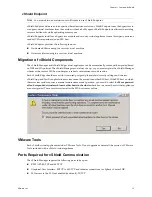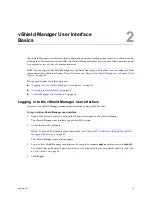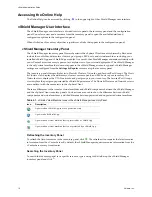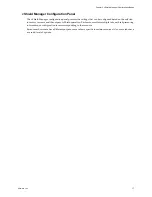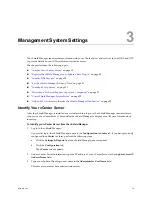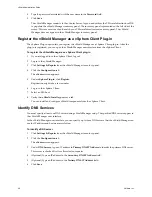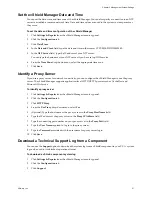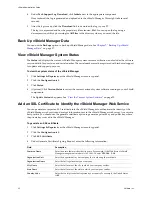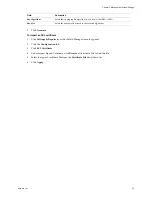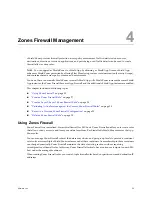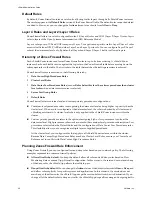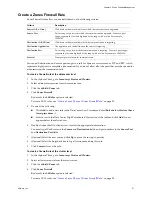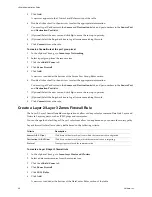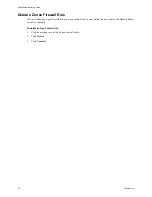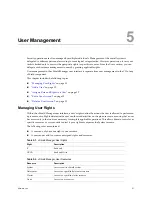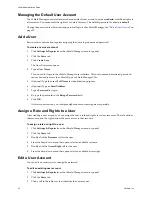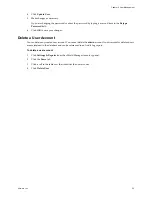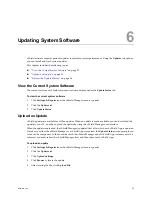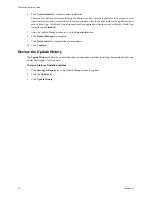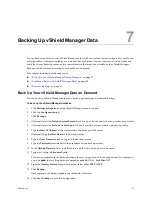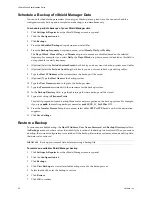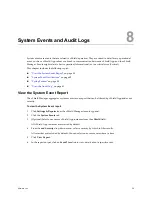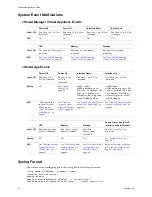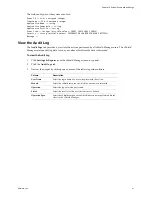
VMware, Inc.
27
Chapter 4 Zones Firewall Management
Create a Zones Firewall Rule
Zones Firewall rules allow or deny traffic based on the following criteria:
You can add destination and source port ranges to a rule for dynamic services such as FTP and RPC, which
require multiple ports to complete a transmission. If you do not allow all of the ports that must be opened for
a transmission, the transmission fails.
To create a firewall rule at the datacenter level
1
In the vSphere Client, go to
Inventory > Hosts and Clusters
.
2
Select a datacenter resource from the resource tree.
3
Click the
vShield Zones
tab.
4
Click
Zones Firewall
.
By default, the
L4 Rules
option is selected.
To create L2/L3 rules, see
“Create a Layer 2/Layer 3 Zones Firewall Rule”
on page 28.
5
Do one of the following:
Click
Add
to add a new rule to the Data Center Low Precedence Rules (
Rules below this level have
lower precedence...
).
Select a row in the Data Center High Precedence Rules section of the table and click
Add
. A new
appears below the selected row.
6
Double-click each cell in the new row to select the appropriate information.
You must type IP addresses in the
Source
and
Destination
fields, and port numbers in the
Source Port
and
Destination Port
fields.
7
(Optional) Select the new row and click
Up
to move the row up in priority.
8
(Optional) Select the
Log
check box to log all sessions matching this rule.
9
Click
Commit
to save the rule.
To create a firewall rule at the cluster level
1
In the vSphere Client, go to
Inventory > Hosts and Clusters
.
2
Select a cluster resource from the resource tree.
3
Click the
vShield Zones
tab.
4
Click
Zones Firewall
.
By default, the
L4 Rules
option is selected.
To create L2/L3 rules, see
“Create a Layer 2/Layer 3 Zones Firewall Rule”
on page 28.
Criteria
Description
Source (A.B.C.D/nn)
IP address with netmask (nn) from which the communication originated
Source Port
Port or range of ports from which the communication originated. To enter a port
range, separate the low and high end of the range with a colon. For example,
1000:1100.
Destination (A.B.C.D/nn)
IP address with netmask (nn) which the communication is targeting
Destination Application
The application on the destination the source is targeting
Destination Port
Port or range of ports which the communication is targeting. To enter a port range,
separate the low and high end of the range with a colon. For example, 1000:1100.
Protocol
Transport protocol used for communication
Содержание VSHIELD APP 1.0.0 UPDATE 1 - API
Страница 9: ...VMware Inc 9 vShield Manager and vShield Zones...
Страница 10: ...vShield Administration Guide 10 VMware Inc...
Страница 14: ...vShield Administration Guide 14 VMware Inc...
Страница 18: ...vShield Administration Guide 18 VMware Inc...
Страница 24: ...vShield Administration Guide 24 VMware Inc...
Страница 34: ...vShield Administration Guide 34 VMware Inc...
Страница 42: ...vShield Administration Guide 42 VMware Inc...
Страница 46: ...vShield Administration Guide 46 VMware Inc...
Страница 47: ...VMware Inc 47 vShield Edge and Port Group Isolation...
Страница 48: ...vShield Administration Guide 48 VMware Inc...
Страница 57: ...VMware Inc 57 vShield App and vShield Endpoint...
Страница 58: ...vShield Administration Guide 58 VMware Inc...
Страница 62: ...vShield Administration Guide 62 VMware Inc...
Страница 68: ...vShield Administration Guide 68 VMware Inc...
Страница 78: ...vShield Administration Guide 78 VMware Inc...
Страница 85: ...VMware Inc 85 Appendixes...
Страница 86: ...vShield Administration Guide 86 VMware Inc...
Страница 130: ...vShield Administration Guide 130 VMware Inc...
Страница 144: ...vShield Administration Guide 144 VMware Inc...

